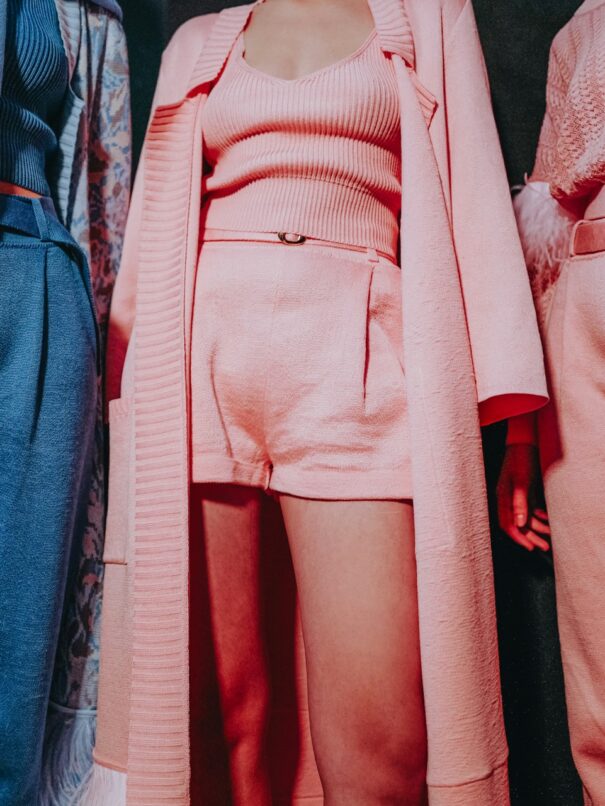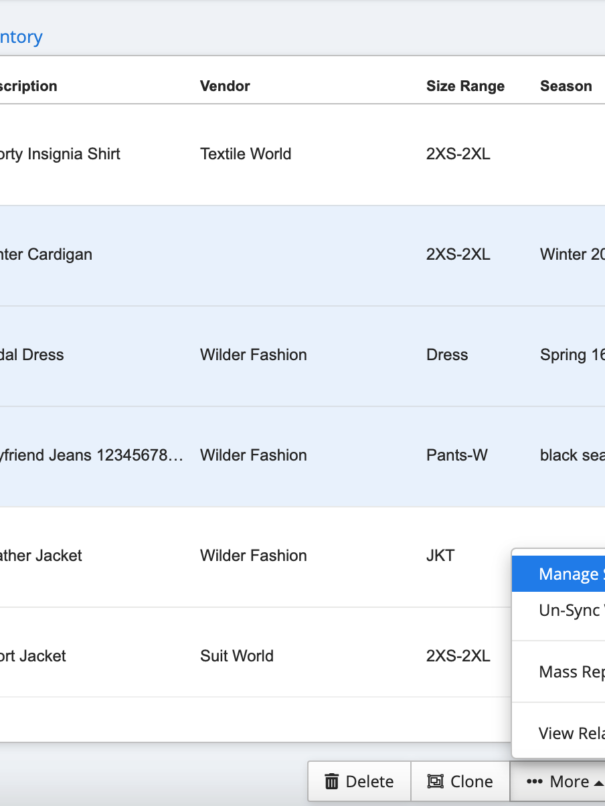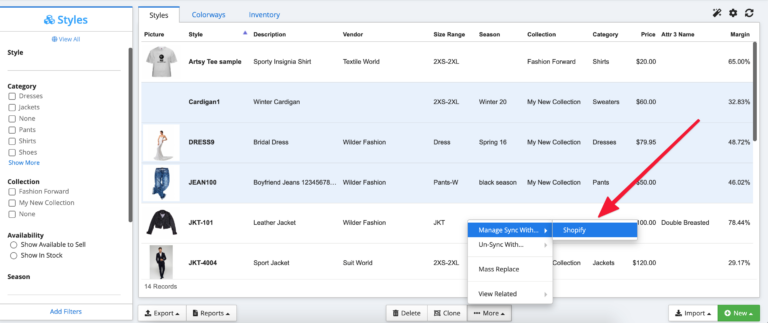Fashion market trends come and go, but one trend that’s here to stay is the increasing integration of technology in the fashion industry. Just like a trendy fashion accessory can boost your outfit, a trendy fashion tech stack can significantly enhance your apparel brand’s success.
Fashion is one of the top money-making industries globally. To stay on top of the industry and keep their customers engaged, apparel brands are increasingly embracing new technology trends. Their online stores must be equipped with user-friendly features, each one guiding them toward the checkout and putting a personal touch to the experience they provide for better engagement and interactivity.
These tech trends are not only increasing revenue and pushing design limits but are also enabling data-driven strategic decisions.
One of the most promising areas of technological innovation in fashion is the integration of enterprise resource planning (ERP) solutions. ERP systems automate and optimize the entire supply chain, from raw materials to the favorite products of customers, monitoring every step of the process in real time. The benefits of ERP in the fashion industry are manifold, including improved inventory management, streamlined operations, enhanced customer service, seamless integrations with CRM systems, increased productivity, and so much more.
Not keeping your eyes on the latest trends, both in technology and fashion can seriously hinder your chances of success in this cut-throat industry. But don’t worry; we prepared a list that outlines the latest technological trends in the fashion industry, so let’s take a deep dive below.
The Importance of Technological Vigilance in the Fashion Industry
Technology continues to revolutionize the fashion industry, fundamentally altering every aspect of business operations. From streamlining the design process to optimizing production, managing inventory, and enhancing customer service, technology plays an integral role. Techs such as artificial intelligence and big data analytics have emerged as game changers, gleaning valuable insights from customer behavior and market trends and empowering apparel brands to make strategic, data-driven decisions.
Moreover, as sustainability takes center stage in the fashion world, technology serves as a pivotal ally, providing innovative solutions to curb waste and bolster efficiency. Digital transformation is also redefining customer interactions with fashion brands. Experiences such as virtual shopping, digital fashion shows, and hyper-personalized online engagements are quickly becoming standard practice.
Brands that fail to adapt to this shift risk losing their competitive edge. Now that we know why it’s paramount to stay in tune with technology, let’s explore the tools that every fashion brand should have in its arsenal.
The Power of ERP in Fashion
The first item in your tech wardrobe should be a good ERP system. ERP systems serve as the go-to technology for fashion businesses as they enable them to easily navigate operations, integrating all facets of the business—from design and production to sales and customer service—into a single, streamlined process.
This integration allows for real-time visibility across the entire supply chain, facilitating better decision-making. For example, with an ERP system, you can accurately forecast demand, manage inventory more efficiently, and respond quickly to changes in the market. Plus, it can help ensure that the right fashion products are in the right place at the right time—a crucial factor in an industry where timing is everything.
AI and Machine Learning: The New Trendsetters
In the world of fashion, predicting trends is a game-changer. That’s where artificial intelligence and machine learning come in. These technologies can analyze vast amounts of data—from social media posts to sales data—to predict what styles, colors, and materials will be in vogue in the coming seasons.
By leveraging these insights, fashion brands can better anticipate customer needs and design their collections accordingly. Moreover, AI can help reduce waste by producing only what is likely to sell, contributing to more sustainable practices in the industry.
eCommerce Platforms: The Digital Runway
With the shift towards online shopping, a solid eCommerce platform is an essential component of any modern tech stack. A good platform should provide an intuitive, seamless shopping experience for customers while offering robust backend features for inventory management, order fulfillment, and customer relationship management.
Your online platform can be the push you need to enter the new era. After all, everyone prefers to shop from the comfort of their home and enjoy fashion shopping experiences with a personal touch.
Moreover, integrating your eCommerce platform with other technologies in your stack—like your ERP system or AI tools—can enhance your operations even further. For instance, AI can personalize shopping experiences based on customer data, while the ERP system ensures that stock levels are accurately reflected on the site.
That being said, your eCommerce tech stack can grow as much as you like it to grow. Shopify and WooCommerce offer various integration options, and you can enable your fashion tech stack to pay dividends for you by the day. In addition to that, as m-commerce grows, mobile apps will become more significant for businesses that want to promote and sell their fashion products. It won’t come as a surprise if all of us are stocking our closets via mobile apps as we are commuting to work.
CRM and Customer Analytics: Keeping in Touch with the Market
Finally, customer relationship management tools and customer analytics play a crucial role in understanding and engaging with your audience. These technologies can help you track customer behavior, preferences, and feedback, providing valuable insights that can inform your design, marketing, and sales strategies.
Virtual Reality (VR) and Augmented Reality (AR) in Fashion
Virtual Reality (VR) and Augmented Reality (AR) are reshaping the fashion industry in several ways:
- Virtual showrooms and stores: Utilizing the power of virtual reality and augmented reality, retailers are revolutionizing the retail space by creating captivating, immersive shopping experiences. Customers, equipped with VR headsets, can traverse the intricacies of virtual showrooms and stores as if they were physically present, all from the comfort of their homes. This virtual realm eradicates geographical boundaries, providing convenience unlike any other.
A prime example of this digital transformation is Tommy Hilfiger’s innovative use of VR to develop a fully immersive virtual store. In this cutting-edge shopping milieu, customers can explore, browse, and purchase fashion products with a level of interactivity and realism that transforms traditional shopping norms. This digital innovation gives customers the sensation of being within arm’s reach of their favorite fashion items, providing a shopping experience that is not just engaging but also incredibly lifelike.
- Virtual fitting rooms: AR technology is being used to create virtual fitting rooms, allowing customers to try on clothes virtually. This can be done using a webcam or a smartphone camera. Customers can see how clothes look on them without having to physically try them on, saving time and reducing the need for returns. Retailers like Zara and ASOS are already using this technology.
- Virtual fashion shows: Designers are using VR to hold virtual fashion shows. This allows them to reach a larger audience, as anyone with a VR headset can attend. For example, Balenciaga presented its Fall 2021 collection in a video game, allowing viewers to explore the collection in a virtual space.
- Design and production: VR and AR can also be used in the design and production process. Designers can create and modify designs in a virtual space, allowing them to visualize and tweak designs before they are physically produced.

Technological Innovations Reshaping Sustainability in the Fashion Industry
Sustainable fashion technologies in the fashion industry are gaining more importance as brands strive to minimize their environmental footprint. Artificial intelligence and data analytics are among the technologies that are being utilized to optimize supply chains and minimize waste. These technologies allow brands to analyze production, sales, and customer behavior data to accurately predict demand, thereby reducing overproduction and wastage.
The fashion industry is also seeing a rise in the adoption of circular fashion tech stack. These include platforms that facilitate the renting or reselling of clothes and technologies that enable the recycling or composting of clothes once they reach the end of their lifespan. An example of this is The Renewal Workshop. Apparel brands such as this one breathe new life into used clothes by cleaning and repairing them.
Technological progress is paving the way for the creation of more sustainable materials. This encompasses bio-based materials, recycled materials, and materials grown in laboratories. For instance, Bolt Threads has developed a material derived from mycelium, which is the root structure of mushrooms, and it can be used as a substitute for leather.
And, going back a bit, with advancements in virtual and augmented reality technologies, digital fashion is becoming a reality. This involves the creation of favorite products for customers virtually that can be worn in virtual spaces or superimposed onto the wearer in photographs or videos. This innovative approach has the potential to decrease the physical production of clothes, which would, in turn, reduce the environmental impact of the fashion industry.
Bottom Line
Staying relevant in the fashion industry is a lot like staying on top of the fashion game—it requires a keen eye on trends and the courage to embrace the new. This is true not just for hemlines and color palettes but for your fashion technology stack as well.
Today’s fashion realm is a high-stakes, digital catwalk. Innovations in technology are revolutionizing the industry, from the back office to the runway to the retail floor. Sophisticated ERP systems have become the spine of business operations, streamlining processes, optimizing inventory, and offering real-time insights across the supply chain.
Artificial intelligence and machine learning are transforming trend prediction, converting heaps of data into actionable fashion forecasts enabling apparel brands to add a personal touch to the experience they offer, while robust online platforms serve as the digital bridges, connecting brands with consumers in an engaging, intuitive online shopping experience.
Meanwhile, technologies such as VR and AR are breaking down barriers between the physical and digital realms, creating immersive shopping experiences, and even influencing design and production processes. CRM tools and customer analytics are unlocking deeper levels of customer engagement and understanding, a veritable treasure trove for targeted marketing and sales strategies.
All in all, consider implementing these technology trends in your tech stack to ensure that you bring the favorite products of your customers in a manner that is personal and engaging.









